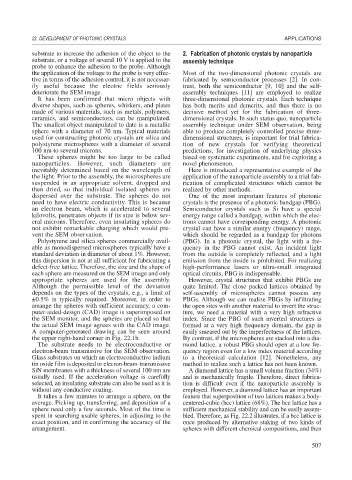Page 535 - Book Hosokawa Nanoparticle Technology Handbook
P. 535
22 DEVELOPMENT OF PHOTONIC CRYSTALS APPLICATIONS
substrate to increase the adhesion of the object to the 2. Fabrication of photonic crystals by nanoparticle
substrate, or a voltage of several 10 V is applied to the assembly technique
probe to enhance the adhesion to the probe. Although
the application of the voltage to the probe is very effec- Most of the two-dimensional photonic crystals are
tive in terms of the adhesion control, it is not necessar- fabricated by semiconductor processes [2]. In con-
ily useful because the electric fields seriously trast, both the semiconductor [9, 10] and the self-
deteriorate the SEM image. assembly techniques [11] are employed to realize
It has been confirmed that micro objects with three-dimensional photonic crystals. Each technique
diverse shapes, such as spheres, whiskers, and plates has both merits and demerits, and thus there is no
made of various materials, such as metals, polymers, decisive method yet for the fabrication of three-
ceramics, and semiconductors, can be manipulated. dimensional crystals. In such status quo, nanoparticle
The smallest object manipulated to date is a metallic assembly technique under SEM observation, being
sphere with a diameter of 70 nm. Typical materials able to produce completely controlled precise three-
used for constructing photonic crystals are silica and dimensional structures, is important for trial fabrica-
polystyrene microspheres with a diameter of several tion of new crystals for verifying theoretical
100 nm to several microns. predictions, for investigation of underlying physics
These spheres might be too large to be called based on systematic experiments, and for exploring a
nanoparticles. However, such diameters are novel phenomenon.
inevitably determined based on the wavelength of Here is introduced a representative example of the
the light. Prior to the assembly, the microspheres are application of the nanoparticle assembly to a trial fab-
suspended in an appropriate solvent, dropped and rication of complicated structures which cannot be
then dried, so that individual isolated spheres are realized by other methods.
dispersed over the substrate. The spheres do not One of the most important features of photonic
need to have electric conductivity. This is because crystals is the presence of a photonic bandgap (PBG).
an electron beam, which is accelerated to several Semiconductor crystals such as Si have a special
kilovolts, penetrates objects if its size is below sev- energy range called a bandgap, within which the elec-
eral microns. Therefore, even insulating spheres do trons cannot have corresponding energy. A photonic
not exhibit remarkable charging which would pre- crystal can have a similar energy (frequency) range,
vent the SEM observation. which should be regarded as a bandgap for photons
Polystyrene and silica spheres commercially avail- (PBG). In a photonic crystal, the light with a fre-
able as monodispersed microspheres typically have a quency in the PBG cannot exist. An incident light
standard deviation in diameter of about 1%. However, from the outside is completely reflected, and a light
this dispersion is not at all sufficient for fabricating a emission from the inside is prohibited. For realizing
defect-free lattice. Therefore, the size and the shape of high-performance lasers or ultra-small integrated
each sphere are measured on the SEM image and only optical circuits, PBG is indispensable.
appropriate spheres are used for the assembly. However, crystal structures that exhibit PBGs are
Although the permissible level of the deviation quite limited. The close packed lattices obtained by
depends on the types of the crystals, e.g., a limit of self-assembly of microspheres cannot possess any
±0.5% is typically required. Moreover, in order to PBGs. Although we can realize PBGs by infiltrating
arrange the spheres with sufficient accuracy, a com- the open sites with another material to invert the struc-
puter-aided-design (CAD) image is superimposed on ture, we need a material with a very high refractive
the SEM monitor, and the spheres are placed so that index. Since the PBG of such inverted structures is
the actual SEM image agrees with the CAD image. formed at a very high frequency domain, the gap is
A computer-generated drawing can be seen around easily smeared out by the imperfectness of the lattices.
the upper right-hand corner in Fig. 22.1b. By contrast, if the microspheres are stacked into a dia-
The substrate needs to be electroconductive or mond lattice, a robust PBG should open at a low fre-
electron-beam transmissive for the SEM observation. quency region even for a low index material according
Glass substrates on which an electroconductive indium to a theoretical calculation [12]. Nonetheless, any
tin oxide film is deposited or elecron-beam-transmissive method to realize such a lattice has not been known.
SiN membranes with a thickness of several 100 nm are A diamond lattice has a small volume fraction (34%)
usually used. If the acceleration voltage is carefully and is mechanically fragile. Therefore, direct fabrica-
selected, an insulating substrate can also be used as it is tion is difficult even if the nanoparticle assembly is
without any conductive coating. employed. However, a diamond lattice has an important
It takes a few minutes to arrange a sphere, on the feature that superposition of two lattices makes a body-
average. Picking up, transferring, and deposition of a centered-cubic (bcc) lattice (68%). The bcc lattice has a
sphere need only a few seconds. Most of the time is sufficient mechanical stability and can be easily assem-
spent in searching usable spheres, in adjusting to the bled. Therefore, as Fig. 22.2 illustrates, if a bcc lattice is
exact position, and in confirming the accuracy of the once produced by alternative staking of two kinds of
arrangement. spheres with different chemical compositions, and then
507

